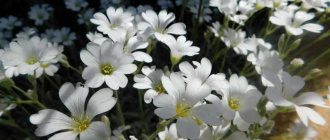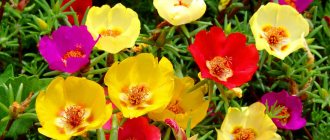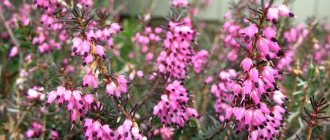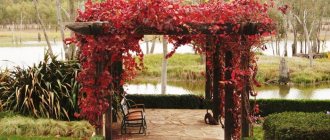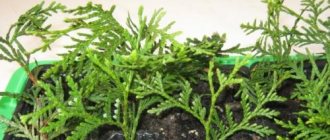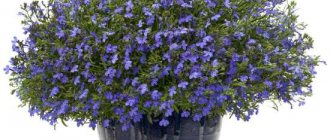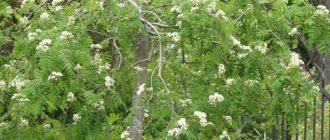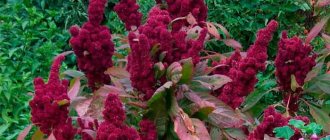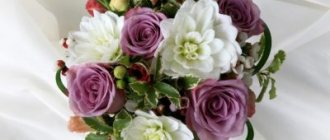Features of growing Brugmansia from cuttings
You can grow Brugmansia from cuttings when the plant is one year old. The general growing strategy will be approximately the same:
- first, cuttings are formed;
- then preliminary rooting of the cuttings is carried out;
- young seedlings are planted in temporary containers, where the rooting process is completed;
- Seedlings ready for transplanting are planted in a permanent place - in a pot or open ground.
Differences in cultivation manifest themselves primarily in the methods of obtaining cuttings. Depending on the time of year when planting material is harvested, the mechanism for its preliminary preparation will be different.
Brugmansia flower growing from seeds
Seed propagation of Brugmansia is considered the simplest, but at the same time not the most preferable, since it does not allow maintaining the purity of hybrid varieties, as a result of which unpleasant surprises are possible at the moment. when the buds begin to form. At the same time, this is the most inexpensive and easiest method to understand whether it is needed on the site.
- Sowing is carried out in February (the deadline is in March), the soil is selected standard from peat, garden soil and sand, and lightly fertilized. It’s not a good idea to bury the seeds—just sprinkle them with a layer of sand before moistening them with warm, settled water from a spray bottle.
- The container must be covered with film, in which several holes are made for air exchange, and placed in an area of diffused light.
- The air temperature near the seedlings should not fall below +20 degrees, and in case of high humidity it is advisable to keep it within +24-25 degrees.
- After 7-10 days, the film is removed, the emerging shoots are sprayed daily (up to 3 times a day) with settled water at room temperature, not allowing the soil to dry out and moisturizing the leaves.
- Picking is done when 4-5 leaves appear, and it is necessary to go through the stage of a separate but small pot before transferring the seedlings to a large pot or open ground.
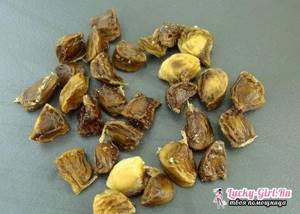
When is the best time to take Brugmansia cuttings?
Usually cuttings are carried out in the fall, in September, or in the spring, in March.
Spring cuttings are more preferable, since in the spring the flower has more active sap flow and it takes root faster. On the other hand, the first flowering of a new plant during autumn cuttings will occur almost a year earlier.
Brugmansia cuttings in autumn
In this case, take branches with a lignified trunk. Theoretically, Brugmansia can be propagated using green cuttings, but the result will be much worse. Preparation of cuttings is carried out before the onset of frost.
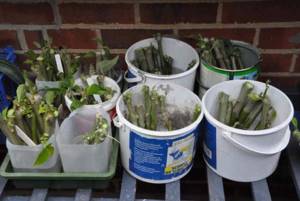
Brugmansia, the cuttings of which were cut in the fall, will bloom the following summer.
Brugmansia cuttings in spring
Brugmansia can also be propagated by cuttings in the spring. Spring cuttings are carried out in a different way. In this case, young shoot tips are used as planting material.
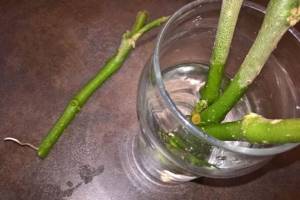
Spring cuttings provide better seed material, but such Brugmansia will bloom, at best, only next year.
Caring for Brugmansia in winter
Wintering Brugmansia must take place according to certain rules, because this plant is still not intended for our climate, and cannot withstand frost.
Already in autumn, when the temperature drops to 5 degrees Celsius, it needs to be moved indoors. It is best to choose a cool, bright place and provide less intense watering than in summer.
Moreover, even in harsh winter, the shrub does not sleep; it can be grown using artificial supplementary lighting. Increase the plant's daylight hours to 14–15 hours and raise the room temperature to 15 degrees. Don’t forget about regular feeding, watering and spraying if the air in the room is dry.
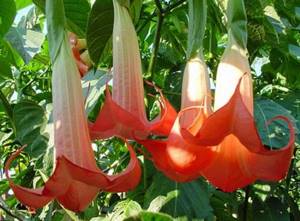
It is worth remembering that the room should be ventilated from time to time, while avoiding drafts. The best options for wintering Brugmansia are a greenhouse or an apartment. If you place it near a window, the plant will continue to bloom.
Brugmansia is a very beautiful plant that requires additional care. But she cannot be called too capricious. And therefore, by showing due patience and attention to the plant, you can admire the beautiful flowers of this queen from spring to autumn, as well as enjoy its magical aroma.
How to propagate Brugmansia from cuttings
When propagating Brugmansia by cuttings, you should decide what result is needed in the end. If the goal is to get a flowering plant as soon as possible, and the percentage of rooted material is unimportant, choose cultivation with autumn cuttings.
In this case, it is necessary to prepare seed material with some reserve, since the method of forming autumn cuttings allows this. On average, autumn seeding material (in the number of cuttings) can be obtained approximately 3 times more than spring seeding.
If the goal is to obtain higher quality seed material, with a higher survival rate, then you will have to sacrifice the speed of the process; in the best case, you will get a flowering plant only a year and a half after the start of cuttings.
The number of cuttings obtained in the spring is significantly less than those obtained in the fall, since the number of young shoots of the plant is limited. On the other hand, they have better survival rate due to their rapid growth and rooting rates.
Below are the features of growing Brugmansia using planting material cut at different times of the year.
Rules for taking cuttings
Depending on when you plan to harvest planting material, the harvesting rules will differ significantly.
Autumn harvesting
The branches are divided into cuttings in such a way that each of them has at least three buds. The length of the segment in this case is not critical; even short shoots 30-40 mm long will do. In this case, very large leaves should be cut off; small leaves and shoots can be left.
Spring harvesting
During spring harvesting, exclusively young shoots up to 20 cm long are used. The lower leaves are cut off from them, and the shoot itself is placed in a container with water, which is covered with a plastic bottle. The neck and bottom of this bottle are cut off.
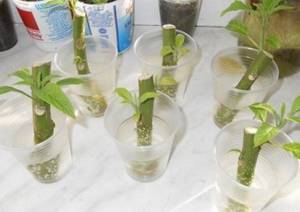
To improve root formation and to prevent leaves from falling from spring cuttings, daily spraying of seedlings with warm water is used.
Preparation of cuttings
Depending on when the cuttings were formed, their preparation will also be different.
During autumn cuttings
The cut cuttings should be installed in a substrate that is a mixture of garden soil and perlite. If rooting occurs in a greenhouse, there is no need to cover the cuttings. If rooting is carried out at home, the box with cuttings should be covered with film. The duration of the rooting process can be quite long - up to 1.5 months.
Rooting Brugmansia cuttings in water has worked well. To do this, the cuttings should be placed in a container with a small amount of water, to which 2 tablets of activated carbon have been added. The container with water should be placed in a dark room.
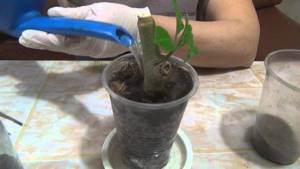
After the cuttings take root, they must be transplanted into individual plastic containers - seedling pots. Further care of the sprouted cutting includes all the necessary procedures for working with plants: watering, fertilizing, weed control, etc.
When cutting in spring
Within a few weeks, small roots will appear on the young cuttings. To finally root Brugmansia cuttings, they should be transplanted into the ground. The composition of the soil can be as follows:
- sand – 1 part;
- perlite – 1 part;
- peat – 2 parts.
After about 15 days, the seedlings can be transplanted to a permanent location. This can be a pot or temporary container where the plant will remain until it is transplanted into open ground.
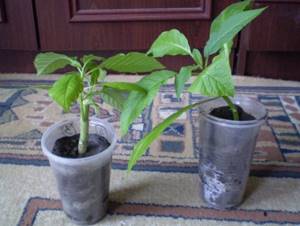
Landing
Further actions for propagating Brugmansia by cuttings are no longer differentiated by how the cuttings were obtained and how their preliminary germination was carried out.
After the process of formation of the root system is completed, care for a young, full-fledged seedling is the same for seed obtained both in spring and autumn.
The criterion that the time has come for planting a young seedling in a permanent place is that its root system almost completely fills the entire free space of the individual container. This moment is easily determined visually either by the roots that have taken up all the space in the jar, or by the raised substrate in a temporary container, from under which the whitish roots of the plant are already protruding.
Reproduction of Brugmansia
More often than other methods, Brugmansia is propagated by stem or apical cuttings, but other methods of obtaining new plants are also used - growing Brugmansia from seeds and by rooting air layering.
Sowing seeds
Seeds are sown in January-March in containers filled with light loose soil to a depth of 0.5-0.8 cm, lightly watered (so as not to wash them) and covered with plastic film or glass.
The containers are placed in a well-heated room, where the thermometer readings are kept within 20-25 degrees Celsius, and in sufficiently bright lighting.
If the planting material turns out to be of high quality, seedlings will not be slow to appear on the 10th day, otherwise – after 40-45 days.
When the seedlings emerge, the film is removed, they are often sprayed with a spray bottle, but not over-moistened.
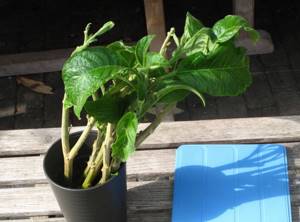
After the formation of the 5th true leaf, the plants are transplanted into separate pots and grown until planted in open ground.
It should be emphasized that Brugmansias grown from seeds will bloom no earlier than in the 2nd or 3rd year and are unlikely to retain the characteristics of the variety identically.
Rooting cuttings
In this way, the plant is propagated throughout the growing season - from spring to late autumn.
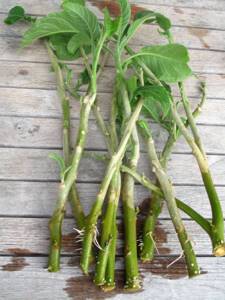
Slightly lignified fragments of twigs 15-20 cm long are cut, the lower leaves are torn off, leaving only 2-3 upper ones, then the lower cut is immersed for several minutes in a rooting agent solution and buried in a damp peat-sand mixture.
Cover the top with a transparent plastic bag.
Rooting continues for a month.
With the appearance of new leaves at the top of the cutting, it becomes clear that it was successful, and the seedling is transplanted to a permanent place in the garden.
When it reaches a height of 30 cm, pinch the top for better branching.
Flower growers with experience in growing Brugmansias claim that cuttings take root easily in ordinary water.
How to propagate Brugmansia by layering?
In spring or summer, a strong semi-lignified shoot from the previous year is selected in the upper part of the crown, which is about to bloom or even bloom.
A triangular cut is made across the stem with a depth approximately equal to a quarter of the thickness of the branch, sprinkled with root or other root formation stimulant and wrapped in damp moss.
Everything is wrapped on top with plastic wrap and secured firmly to the stem, but in such a way that it remains possible to regularly moisten the moss.
After about a month and a half, roots form, and the film is carefully removed, and the cuttings are cut off from the mother plant and planted in a permanent place of growth.
Transplantation into open ground
After the seedling has grown stronger, it is moved to a larger pot or the plant is transplanted into open ground. In open ground in a sunny area, it is necessary to make a hole 50 cm deep and 70-80 cm in diameter. A drainage layer in the form of broken bricks or crushed stone is laid at the bottom of the hole. A layer of humus or compost is placed on top of the drainage layer.
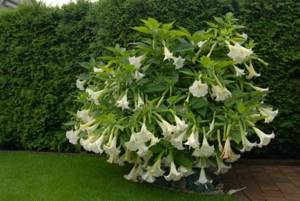
The young plant is replanted entirely with the lump of earth in which it grew in the pot. To avoid injury to the root system, the transshipment method should be used. The space around the lump is filled with earth, it is lightly compacted and watered.
Caring for an adult plant at home
Brugmansia is one of the light-loving flowers. When daylight is short in winter, the plant is removed to a cooler place until spring arrives. This dormant period will benefit the flower.
Since Brugmansia loves warmth, temperatures below +50C are destructive. The most favorable conditions for a flower in summer are +22 - +250C. In winter, the thermometer numbers can be lowered slightly.
It is strictly not recommended to keep the flowerpot near heating devices.
Features of care:
- Irrigation. In the warm half of the year, while Brugmansia is actively growing, it is watered abundantly. As the flowers bloom, the amount of water is reduced. In winter, irrigation is carried out very rarely. It is necessary to carry out the watering procedure during the heating season only when the top layer of soil dries well.
- Transfer. When growing Brugmansia using cuttings, you should change the soil and container several times a season. For this purpose, the “transshipment” method is used. In this way, the young flower will quickly take root in a new place and will delight you with abundant flowering. In this case, be sure to add a little mineral fertilizer or chicken droppings to the pot.
- Substrate. This species belongs to the group of fast-growing plants. Therefore, in order for it to develop properly, you need to use soil with a large amount of nutritional components. Brugmansia has no requirements for soil acidity. For planting a plant, a purchased substrate or a homemade mixture based on compost, peat and river sand, taken in equal volumes, is suitable.
During the period of bud formation, the crop needs to be fertilized with mineral compounds rich in potassium and phosphorus.
With a little effort, Brugmansia seeds will grow into a beautiful, exotic plant called the “trumpet of angels.” With proper care, the tree will delight you with its unique blooms several times a year. You can observe this amazing process throughout the summer and right up to the end of December.
Post navigation
Fill the plant well, wait until the water is absorbed, and bring the plant into a room where the temperature will not be lower than +10...+15 degrees. WITH.
An adult Brugmansia can live up to 10 years, but you must remember that it only overwinters indoors.
Brugmansia video
| Brugmansia This plant has many amazing names in different countries: archangel's trumpet, angelic stars, floripondio, bell, datura tree, wood datura. Devil's tree - it is called for its poisonous properties. Botanists call it Brugmansia, assigning Latin names to its species and hybrids... |
How to grow Brugmansia in a pot
Brugmansia belongs to the Solanaceae family. Previously, representatives of this genus belonged to the Datura genus, then, based on the combination of properties, they were separated into a separate genus. Brugmansia candida is grown as an ornamental plant. This is a heat-loving shrub or small tree with unusually large drooping bell-shaped flowers. Its homeland is South America.
Brugmansia is known in literature as the Datura tree. All parts of it contain intoxicating substances that are hazardous to health. But this plant is also called Angel Trumpets for the beauty of its amazing flowers.
Brugmansia has long been known as a garden plant in those areas where winters are quite mild: in the countries of Southern Europe, in the Crimea, in the Caucasus. In harsher climates in winter there is a risk of complete freezing. In recent years, many new varieties with different flower colors have appeared, which has attracted the attention of indoor plant lovers.
It turned out that Brugmansia is an excellent plant for growing in a tub on the balcony. A large bush or tree can decorate a terrace or patio, as can palm trees, hibiscus, ficus, and lemons. But when the time of flowering comes and huge fragrant bells of flowers appear, it becomes clear that Brugmansia has no equal among house plants!
The height of the bush often reaches 1.5-2 meters, although in the subtropics it is much higher. In spring and summer, the stems grow very quickly and become woody slowly. To get a beautiful bush or tree, you need to remove excess side shoots.
Brugmansia leaves are oval, petiolate, with smooth edges, slightly pubescent. The roots also grow very quickly, first forming a dense lump at the surface, then sending long roots into the depths.
Flowers are the main charm of this plant. They are tubular, hanging, reach a length of 20-25 cm, a diameter of up to 15 cm, and have a strong aroma, especially in the evening. Color – white, yellow, pink, there are varieties with color transitions from the base to the edges of the corolla. Flowering begins quite late, after the formation of the above-ground part, and occurs in waves, in several passes.
It is noteworthy that when growing Brugmansia in the garden, buds begin to form towards the end of summer, when the cold nights begin. Therefore, there is no need to be afraid to expose the tub to the open air in the spring. As soon as the threat of frost has passed, this can already be done. Night temperatures of +5 are quite well tolerated by the plant.
Tips for growing Brugmansia
Lighting . A light-loving plant, in case of insufficient light it is better to keep it in a cool room in a dormant state until spring.
Temperature . Brugmansia loves warmth; temperatures below +5 are dangerous for most varieties. In summer 22-26 degrees is quite suitable
Watering. In spring and summer, during rapid growth, water abundantly. After the flowers appear, growth usually stops, so you can water less. In winter, watering is scanty, just so that the earthen ball does not dry out.
Fertilizer . They say that it is impossible to overfeed Brugmansia; all feeding only benefits it. In the spring, during growth, fertilize with complex fertilizer once a week so that the bush grows green mass.
Summer care for Brugmansia
- The choice of location in the garden is based on the fact that Brugmansia is a southerner and, accordingly, prefers sunny places protected from the wind. The plant also loves light, fertile soils: a mixture of loam, humus or compost and 2 parts peat. The mixture is mixed and poured with a solution of potassium permanganate. You can also use ready-made soil, but it is better to add humus or compost to it to increase fertility.
- If the weather is hot in the summer, then the “datura” needs daily and abundant watering; in cloudy weather, this is done from time to time. It is also recommended to spray the plant in dry weather.
- At the same time, you should be careful not to over-moisten the beauty. To prevent rotting, the soil must be drained.
- From planting to mid-September, complex fertilizers intended for flowering plants should be applied to the soil once a week. This complex usually contains ash, potassium and phosphorus. The described species is very sensitive to the lack of these elements. When they are deficient, the leaves begin to turn yellow and fall off. By the end of the summer period, the dose of fertilizer is reduced, and in September, feeding stops completely.
- Also, do not forget about pruning the bushes, which is best done no later than March. You should not remove Y-like shoots on which flower stalks form. It is necessary to cut off only damaged and diseased shoots; the rest should be shortened. In addition, there is no need to cut off the small side shoots of the upper part of the crown that grow horizontally. After all, they are the key to the formation of a beautiful plant crown and are the basic flower stalks.
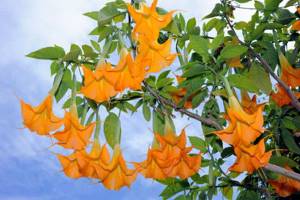
Brugmansia: planting, growing, care and propagation in open ground. 75 photos of a beautiful flower
From the beginning of summer you can feed with fertilizer for flowering plants.
Transplant . When growing Brugmansia from a cutting in a pot, as it grows, it must be transferred several times a season to a larger pot without destroying the earthen ball. Each time you replant, you should add mineral fertilizer or a little chicken manure to the pot.
The soil . Brugmansia grows quickly, so it requires nutritious soil. The acidity of the soil is not particularly important. A mixture of peat, humus and sand in equal quantities works well. You can use store-bought palm mix.
Outdoor maintenance . In summer, be sure to take the tub with the Brugmansia flower out into the open air, into the yard, onto the open veranda or onto the balcony. A sunny but ventilated place is suitable; a too hot glazed balcony on the south side is not suitable. Grows well on the balcony, where there is sun for several hours in the morning or at sunset.
Important ! The pot should be heavy or secured in place. The wind causes the large plant to topple over.
Trimming . Brugmansia, like other nightshades, is prone to the formation of stepsons (young shoots between the trunk and the leaf); the stepsons must be removed in order to speed up the onset of flowering.
With the onset of cold weather, the plant must be moved into the apartment, and it must be trimmed. You can safely trim the upper forks of the shoots; after rooting, they can bloom.
Wintering . In winter, water less often and do not fertilize; the less it grows, the less the shoots stretch from lack of light. It is better to keep in a cool place. It is advisable to provide lighting so that there is at least 12 hours of daylight per day. In the spring, watering is increased and Brugmansia begins to be fed, then transplanted into a new pot.
If it is not possible to store the plant in a bright room in winter, or you want to preserve Brugmansia growing in the garden, then there is another way. The plant is trimmed so that only woody parts remain and placed in a cool, dry basement. In the same way, a garden bush is dug out of the ground and, if necessary, divided into several parts. Each part is placed in a large pot and brought into the basement.
Reproduction . Propagated by seeds and cuttings. Propagation by cuttings is more reliable; plants retain the properties of their parents. Seedlings grown from seeds can bloom only after several years.
Brugmansia cuttings come in two types: stem and apical. Apical branched cuttings are preferable. Once they take root, you can expect flowering.
Cuttings are taken 15-20 cm long, large leaves are removed and placed in water. Roots appear at the end of the cutting. You can plant them deep in the soil; the roots then grow along the entire length of the deepened cutting. Along with the roots, new shoots also grow from the lateral buds. A month after planting, the roots fill the pot and begin to emerge through the hole in the bottom. It's time to transfer it to a larger pot.
Planting, features of growing from seeds
Before planting Brugmansia, you need to take care of preparing a suitable soil mixture, since in its homeland the flower grows on very fertile loams, which will have to be recreated.

To do this, take an equal volume of vermicompost and clay soil and mix it with two parts of peat. After thorough mixing, pour in a weak solution of potassium permanganate for sterilization. This substrate is excellent for planting young seedlings, replanting adult plants and sowing seeds.
Reproduction of Brugmansia by seeds is quite labor-intensive and is associated with the main disadvantage - the inability of plants grown from seeds of hybrid varieties to inherit the characteristics of the shape and size of the flowers of the parent individuals.
The time from the beginning of January to the end of March is considered optimal for sowing seeds. To do this, the prepared substrate is loosened, moistened, and the seeds are planted to a depth of 1 cm, after which they are covered with film.
Shoots appear closer to 4-6 weeks, after which the film is removed and the soil is lightly moistened up to 2 times a day to prevent drying out. After four true leaves appear, the seedlings are transplanted to permanent locations.
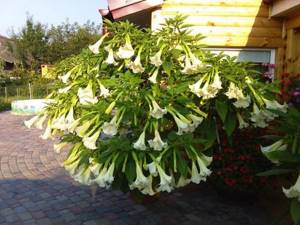
A few weeks after replanting, the first fertilizing is carried out with nitrogen fertilizer, and then fertilized monthly with universal fertilizer. The first flowers after propagation by seeds will appear after at least a year of plant life.
Brugmansia seeds are quite dense. To speed up germination, they are soaked for a day in a root formation stimulator, after scratching the surface of the seed with a knife or other sharp object to break the integrity of the hard shell.
Rules of care
Brugmansia does not tolerate frost, which is why its home is a large, stable container that can hold a lot of substrate, but in warm weather it grows well in the garden, preferring sunny places. Caring for the plant consists of observing the following rules:
- Transfer. Produced in the spring in a pot larger in size than the previous one, or in open ground when stable positive temperatures are reached. For abundant flowering, the plant needs bright light and fresh air.
- Watering. The plant is characterized by the presence of large leaves that intensively evaporate moisture and are sensitive to strong winds. A place for Brugmansia is selected with plenty of sun, but protected from strong winds. Maintaining the water regime consists of abundant watering once a day in warm weather, and in hot weather twice a day with excess water. The plant reacts to its deficiency by shedding leaves and buds.
- Trimming. Brugmansia requires this method of care all year round: branches growing below the first forks are removed, but knotty and small ones should be left, as flowers appear from them.
- Feeding. Along with replanting the plant, chicken droppings or fertilizers for indoor plants are added to the soil mixture. The crop loves organic matter, but also needs mineral fertilizing, especially phosphorus-potassium, before and during flowering.
- Wintering. When temperatures reach about 5-7°C in autumn, the plant is transplanted into a pot, heavily cutting off the roots and treating them with charcoal. In winter, the optimal temperature will be 10-15°C, but it should not be allowed to drop to 5-6°C. Failure to comply with such conditions threatens Brugmansia with death.
- Disease and pest control. Pests that often attack the plant include whiteflies, aphids, caterpillars, slugs and spider mites. The plant must be periodically examined and, if necessary, treated with pesticides. Of the diseases, gray rot most often causes harm, which, when detected, is destroyed with a fungicide.
There is an option for overwintering Brugmansia, in which it is placed in a dark room with a temperature of about 5°C, and the plant will shed all its leaves, which will be restored in the spring. Watering should be minimal, just to prevent the roots from drying out.
Growing Brugmansia in open ground is not particularly difficult. The main thing is to follow the rules of care and find a suitable room for overwintering the plant.
Caring for a tree will be a pleasant experience for any gardener, who will reward all their efforts with its picturesque view and huge fragrant flowers.
Exotic Brugmansia - planting and care in open ground
- 0.00 / 5
5
- 1 / 5
- 2 / 5
- 3 / 5
- 4 / 5
- 5 / 5
votes, 0.00 avg. rating (% score)
Video: #Cuttings_brugmansia part 1
In autumn, when the temperature drops - 5-6 °C is already a critical temperature for Brugmansia - it needs to be dug up. That is, the upper part (aerial part) is cut off from the ground by approximately 40 cm. I replant it into a container, depending on what kind of roots it is, or into a box or some other container. I cover it with soil, the same one where it grew, and bring it into a cool room, into the basement. The temperature in the basement should be at least 6 °C; if stored in a room, the temperature should be from 10 to 12 °C - this is the optimal temperature for storing the flower.
You don't have to cut the flower at all.
Brugmansia - planting and care, watering, reproduction in three ways
If you have conditions where you can preserve it in the same form as it grew, this will be even better, since it will begin flowering earlier and will bloom more profusely. If you want not only to preserve the plant, but also to propagate Brugmansia, then cut the upper part that was cut into cuttings, about 15-20 cm, and you can put it in, say, a 5-liter polyethylene container with soil, make drainage holes at the bottom. Water it, put it in the basement, let it stay like that until the beginning of February. In February, you need to take out this container and place it in a brighter place, continue to water it, and then Brugmansia will begin to develop, roots and shoots will begin to appear.
This year I decided to conduct an experiment. I put two cuttings in a box with damp sand, slightly damp, this box was in my basement. A week ago I took out these two cuttings, cut off the lower part, renewed it, poured charcoal or activated carbon into a jar, poured a little water, about 2 cm. Roots most often form at the border of water and air. There is more oxygen in the upper part of the water, and oxygen is needed for the formation of roots. What is activated carbon or charcoal for? To prevent the water from rotting. Periodically you need to look, if the water begins to become cloudy or some kind of mucus appears, you must definitely change the water. The water should be settled, warm, and we also add charcoal or activated carbon. These cuttings have been standing in water for a week now. I want to show you: callus has begun to form, that is, these are the beginnings of roots, these little white dots. But in this place – this kidney has awakened.
Next we will show you how the roots and this little green bud will develop. Look.
Author: Igor February 18, 2021 Category: Reproduction
Video of Brugmansia propagation by cuttings. We have already shown two videos about a wonderful and very beautiful perennial flower - Brugmansia. In the first video we showed how Brugmansia blooms, told how to care for it, and in the second we showed repeated flowering in the fall. Today I want to talk about one of the methods of propagating Brugmansia.
Brugmansia cuttings - video
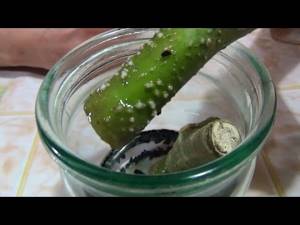
In autumn, when the temperature drops - 5-6 °C is already a critical temperature for Brugmansia - it needs to be dug up. That is, the upper part (aerial part) is cut off from the ground by approximately 40 cm. I replant it into a container, depending on what kind of roots it is, or into a box or some other container. I cover it with soil, the same one where it grew, and bring it into a cool room, into the basement. The temperature in the basement should be at least 6 °C; if stored in a room, the temperature should be from 10 to 12 °C - this is the optimal temperature for storing the flower.
You don't have to cut the flower at all. If you have conditions where you can preserve it in the same form as it grew, this will be even better, since it will begin flowering earlier and will bloom more profusely. If you want not only to preserve the plant, but also to propagate Brugmansia, then cut the upper part that was cut into cuttings, about 15-20 cm, and you can put it in, say, a 5-liter polyethylene container with soil, make drainage holes at the bottom. Water it, put it in the basement, let it stay like that until the beginning of February. In February, you need to take out this container and place it in a brighter place, continue to water it, and then Brugmansia will begin to develop, roots and shoots will begin to appear.
This year I decided to conduct an experiment. I put two cuttings in a box with damp sand, slightly damp, this box was in my basement. A week ago I took out these two cuttings, cut off the lower part, renewed it, poured charcoal or activated carbon into a jar, poured a little water, about 2 cm. Roots most often form at the border of water and air. There is more oxygen in the upper part of the water, and oxygen is needed for the formation of roots. What is activated carbon or charcoal for? To prevent the water from rotting. Periodically you need to look, if the water begins to become cloudy or some kind of mucus appears, you must definitely change the water. The water should be settled, warm, and we also add charcoal or activated carbon. These cuttings have been standing in water for a week now. I want to show you: callus has begun to form, that is, these are the beginnings of roots, these little white dots. But in this place – this kidney has awakened.
Next we will show you how the roots and this little green bud will develop. Look.
271
